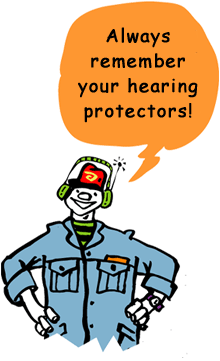Noise Exposure
When estimating the risk of hearing loss or determining if a work regulation noise limit is exceeded, the noise exposure must be measured and calculated. Noise exposure is the average noise level over a whole work day.
To calculate the noise exposure level over a work day, both the length of time of each noisy task and the sound level near the ears must be known. Then the partial noise exposure for each noisy task can be calculated as well as the noise exposure level for a whole workday.
Values in dB(A) cannot be added directly together in that dB is in a logarithmic scale. If one has for example a machine producing noise at 80 dB and then starts a similar machine in the same area, the sound level increases by 3 dB to a total of 83 dB. A doubling of the transmitted sound is therefore an increment of 3 dB. An increase of 3 dB results in a doubling of the wear on a person’s hearing.
If a person is exposed to a single noise source over a workday, a noise exposure level of 80 dB(A) is attained after:
8 hours work in 80 dB(A)
4 hours work in 83 dB(A)
2 hours work in 86 dB(A)
1 hours work in dB(A)
30 minutes work in 92 dB(A)
15 minutes work in 95 dB(A)
8 minutes work in 98 dB(A)
4 minutes work in 101 dB(A)
2 minutes work in 104 dB(A)
1 minutes work in 107 dB(A)
30 seconds work in 110 dB(A)
If a person for example cuts with an angle grinder that emits noise at 110dB(A) in the ear area, and does not receive any additional noise exposure over a workday, the 8-hour noise exposure level comes to 80 dB(A) after 30 seconds of cutting. After approximately 2 minutes the work regulation limit of 85 dB(A) would be exceeded.

